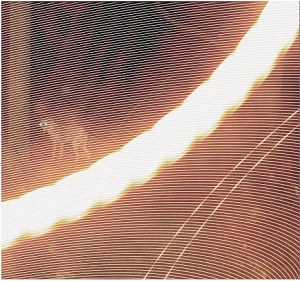Mike Majkowski, "Bright Astonishment of the Night"
 Scale, repetition, and variation have a way of bringing Morton Feldman to mind whether or not Feldman has anything to do with the matter at hand. The matter in this case is Mike Majkowski’s Bright Astonishment of the Night, the second of two full-length albums he released in 2015. The other, Neighbouring Objects, focused on the sympathetic resonances between instruments like piano, chimes, and double bass. This one focuses exclusively on the double bass over two long tracks, one of which, titled "Sleep and Oblivion," runs for over 48 minutes. Majkowski spends much of that time cycling through a series of techniques that emphasize the weight and extent of his instrument: the way it travels through the room, the way it melds into the walls at low frequencies and cuts through the air at higher ones, and the way those extremes relate. Resonance is still the subject of his work, but in this case it’s cast against a play of repetition and variation that holds equal weight.
Scale, repetition, and variation have a way of bringing Morton Feldman to mind whether or not Feldman has anything to do with the matter at hand. The matter in this case is Mike Majkowski’s Bright Astonishment of the Night, the second of two full-length albums he released in 2015. The other, Neighbouring Objects, focused on the sympathetic resonances between instruments like piano, chimes, and double bass. This one focuses exclusively on the double bass over two long tracks, one of which, titled "Sleep and Oblivion," runs for over 48 minutes. Majkowski spends much of that time cycling through a series of techniques that emphasize the weight and extent of his instrument: the way it travels through the room, the way it melds into the walls at low frequencies and cuts through the air at higher ones, and the way those extremes relate. Resonance is still the subject of his work, but in this case it’s cast against a play of repetition and variation that holds equal weight.
Time was an important concept for Morton Feldman in the latter part of his career, from 1983 until his death in 1987. It was during those four years that he completed pieces like String Quartet No. 2, For Philip Guston, and For Christian Wolff, all of which challenge performers to concentrate on exceedingly tricky scores for anywhere between two and six hours, depending on the tempo the group chooses. Mike Majkowski doesn’t make that kind of demand on his audience or on himself, but like Feldman he utilizes long periods of time to get at ideas and sounds that other musical elements aren’t as well-equipped to produce. Chief among these are the shape of sound and the shape of time.
The bulk of "Sleep and Oblivion" is composed of double bass figures that either pop and resound or flash in straight, short lines, like beams of light. The contrasting high and low tones create a gaping space between, which is filled in as each passage slows down and drifts toward silence. Just as inertia seems poised to take over, the sudden pop and large low tone that started the last section springs back and the music resumes its slow crawl forward. Majkowski returns to figures like these throughout the piece. Sometimes they sound like near exact reproductions of sections that have come before, other times they are clearly variations with different melodies or rhythms. For the most part, however, the music cleaves to the same tonal center—minor, dark and maybe a little gloomy—so what melodic variation there is is a matter of small movements up and down. The durations and rhythms are much easier to pick out and much easier to remember as iteration after iteration falls into the past.
Buried between these repetitions are some surprising tangents: the combination of bowed and plucked strings at minute 23, a long low drone that never comes back at minute 32, a unique series of percussive tones struck with only three minutes left. Folded up inside the well-established patterns and seemingly constant cycles of "Sleep and Oblivion" are these unpredictable and otherwise unrelated intervals. Majkowski spends a lot of time lulling the ears into submission, conditioning them to expect another recognizable series or another recognizable technique. This is where time and its shape become a factor. Given enough space, time obscures, hides, or otherwise erases, makes identification and remembering a task, not because it must be that way, but because the content of the music, the way it is shaped, works to the same end. The shapes of time and sound are related just like the length of a sine wave and its tone are, except that, at large distances and over long periods, the effect is the dissolution of patterns and structures. There are many places, some of them dramatic, where Majkowski could have stopped his piece, but he chooses to continue with the process instead, thereby eliminating the feeling of completion associated with resolution, whether melodic, rhythmic, or otherwise.
In light of that disjunction, "Ultramarine" is a surprise. An 18-minute coda that sticks to quickly bowed drones, it neither completes nor resolves the tension of "Sleep and Oblivion" and, because of its shorter duration, ultimately disappears into the shadow of that piece. Similar ideas are at work—the same rapid bowing is used to produce a bright harmonic glow up and down the neck for the entire piece—but the subject is more melodic and more colorful, less preoccupied with structure. Duration still matters, but in this case it serves the contradiction between the short quick movements of Majkowski’s hands and the resonant luminescence of the strings, like watching an old film on a hand-cranked projector. In any case, "Ultramarine" is more of a departure than a continuation of "Sleep and Oblivion" and probably should have been given more space than is provided. That sequencing decision is the only hiccup on an otherwise deliberate and challenging record.
samples:
 



